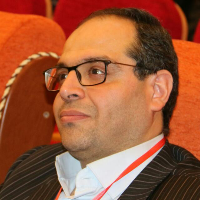Estimation of land surface temperature and vegetation effects on surface temperature by using bands of MODIS images (case study: toysercan basin)
Author(s):
Abstract:
Study of Terrain Including vegetation, water resources, land types Including soil texture and classification are cases that require data with high precision. Accurate and high quality data can lead us to a better, more accurate results.In this context, remote sensing data is a great tool for the detection and identification of patterns. SEBAL (surface energy balance algorithm) is a relatively new algorithm for estimating evapotranspiration in most parts of the world and other heat fluxes and land surface temperatures used and the results have been satisfactory. To estimate the surface temperature in the Tuyserkan district using data SEBAL algorithm, bands of MODIS images were used. The main objective of this study was to evaluate the accuracy of remote sensing methods to estimate the surface temperature and the best method is introduced. The highest temperature in the region of 315 ° K and the minimum temperature is 287 degrees Kelvin. Heights with respect to a given temperature are the minimum temperature gradient. Areas of vegetation are more moderate temperatures in the region.
Keywords:
Language:
Persian
Published:
Quarterly of Geography (Regional Planing), Volume:6 Issue: 3, 2016
Pages:
23 to 32
https://www.magiran.com/p1739393
سامانه نویسندگان
مقالات دیگری از این نویسنده (گان)
-
Presenting the Model of Social Sustainability in New-Foundation Neighborhoods
Mehdi Khodaei, Ahmad Khademolhoseiny *, Safar Ghaedrahmati,
Journal of Urban Management and Energy Sustainability, Winter 2025 -
Smartening Police Security Services to Tourists in Iran
Majid Farhadi Uonaki *, , Seyyed Mohammad Saeb
Entezam - e - Ejtemaei, -
Forecasting the Demand of Medical Tourists in Yazd Using Artificial Neural Network
Hamidreza Fallah Tafti, Ahmad Esteghlal*, Seyed Ali Al-Modaresi, Zohreh Beheshtipour, Seyed Majid Mirhosseini
Management Strategies in Health System, -
Land Subsidence Hazard Assessment using Weights-of-Evidence model (Case Study: Karaj City)
Somayeh Taheri *, Hasan Ahmadi, Jamal Ghodousi, Sadat Feiznia, Shahram Khalighi Sigaroudi, Mohamadhossein Ramesht
Journal of Range and Watershed Management, -
Territorial climatic identity and water resource management policies from the perspective of geomorphology
Farokh Malekzadeh, Mohammedhossain Ramesht *, Somayeh Sadat Shahzeidi
quantitative geomorphological researches, -
Identifying, categorizing and ranking performance indicators of schools using Q method
Seyed Mahmoud Jalilian, Shahnaz Naibzadeh *, Seyyed Hasan Hataminasab, Seyed Ali Almodaresi
Journal of Management and educational perspective,





